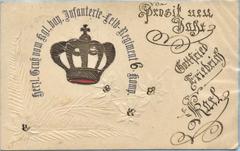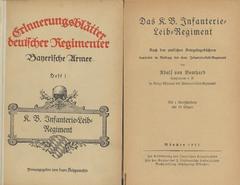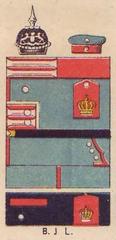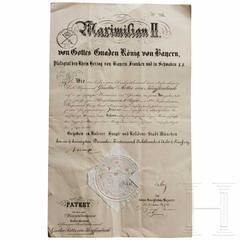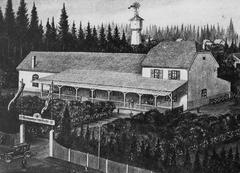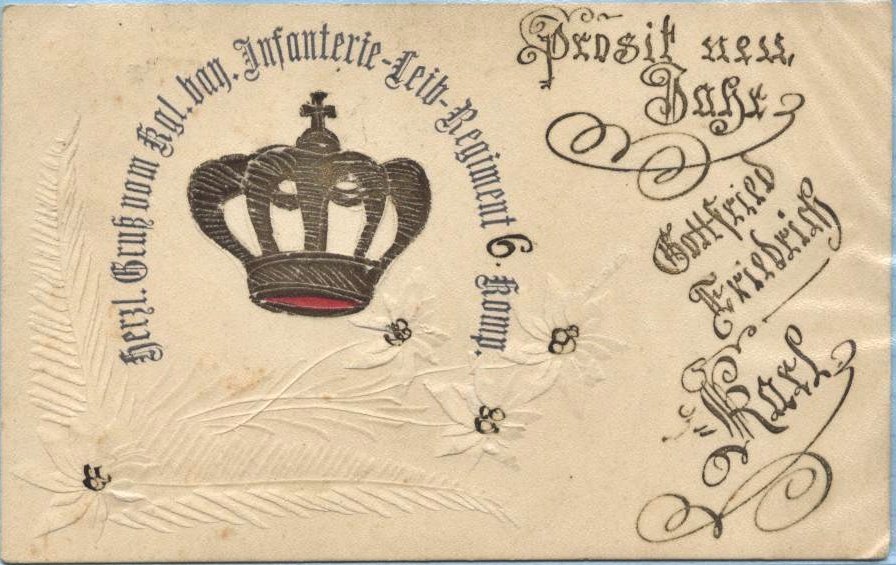
Royal Bavarian Infantry Lifeguards Regiment Munich: Visiting Hours, Tickets, and Historical Sites Guide
Date: 14/06/2025
Introduction: Exploring Munich’s Royal Bavarian Infantry Lifeguards Regiment
Munich, the capital of Bavaria, is a treasure trove for history enthusiasts, offering a window into the region’s military heritage through sites connected to the Royal Bavarian Infantry Lifeguards Regiment. Established in 1814, this elite unit symbolized Bavarian military excellence and its close association with the Wittelsbach monarchy. The regiment played pivotal roles in major European conflicts—including the Austro-Prussian War, the Franco-Prussian War, and World War I—before its disbandment in 1918.
Today, the legacy of the Lifeguards Regiment is commemorated across Munich and nearby Ingolstadt. Visitors can explore the Royal Bavarian Infantry Lifeguards Regiment Monument, the historic Türkentor (the last remnant of the regiment’s barracks), the Feldherrnhalle at Odeonsplatz, and a selection of museums and memorials. These sites not only recount the regiment’s military achievements but also illuminate Bavaria’s transformation from a kingdom to a modern state.
Set within Munich’s vibrant cultural quarters, these landmarks are easily accessible and often close to other attractions, traditional eateries, and museums. To enhance your experience, resources like the Audiala app provide audio tours and interactive maps. For the latest on events and exhibitions, reference the Munich Tourism Website.
This guide offers essential information on visiting hours, ticketing, accessibility, guided tours, and tips—helping you make the most of your journey through Bavaria’s living military legacy. (Royal Bavarian Infantry Lifeguards Regiment Monument, Türkentor and Munich Museums, Feldherrnhalle Munich)
Table of Contents
- Discover the Royal Bavarian Infantry Lifeguards Regiment Monument in Munich
- The Lifeguards Regiment and the Historic Türkentor
- Key Historical Sites in Munich
- Feldherrnhalle and Odeonsplatz
- Summary and Final Recommendations
Discover the Royal Bavarian Infantry Lifeguards Regiment Monument in Munich
Historical Overview
Founded in 1814, the Royal Bavarian Infantry Lifeguards Regiment (Königlich Bayerisches Infanterie-Leib-Regiment) was an elite formation selected from Bavaria’s tallest and most skilled soldiers. Closely tied to the Wittelsbach dynasty, it played both ceremonial and active military roles in Europe’s defining wars. The Regiment Monument honors the valor and tradition of this prestigious unit, marking Bavaria’s evolution from monarchy to a federal state.
Visiting Information
- Location: Central Munich, near historic parade grounds and former barracks.
- Hours: Daily, 9:00 AM – 6:00 PM. Closed January 1st and Christmas Day.
- Admission: Free. Guided tours available on weekends/public holidays (tickets on-site or online; advance booking recommended for groups 10+).
Accessibility and Tips
- Accessible: Wheelchair-friendly with ramps and multi-language plaques (German, English, French).
- Best Times: Early morning or late afternoon for quieter visits and optimal photography.
- Nearby: Bavarian Army Museum (Ingolstadt), Munich Residenz, Old Town.
Cultural Significance and FAQ
The monument is a symbol of Bavarian identity, integrating elements from the regiment’s uniforms and insignia—making it a highlight for both history lovers and casual visitors.
FAQs:
- Entrance Fee? Free.
- Guided Tours? Yes, weekends and holidays (booking recommended).
- Public Transport? U-Bahn Odeonsplatz station nearby.
- Year-Round Access? Yes, except major holidays.
- Accessibility? Fully wheelchair accessible.
The Lifeguards Regiment and the Historic Türkentor
Historical Importance and Symbolism
The Lifeguards Regiment, founded in 1814, served as the king’s personal guard and embodied Bavarian sovereignty. Its prestigious status persisted even after Bavaria joined the German Empire in 1871, with unique uniforms and allegiance sworn directly to the king.
Visiting Hours, Entry, and Events
- Türkentor (Turkish Gate): The last surviving structure of the regiment’s barracks, now a modern art space hosting Walter De Maria’s “Large Red Sphere.”
- Location: Türkenstraße, museum quarter.
- Hours: Daily, 10:00 AM – 6:00 PM.
- Admission: Free.
- Accessibility: Wheelchair accessible.
- Guided Tours: Weekends and public holidays; check schedules via the Munich Tourism Website.
Social and Cultural Impact
The Lifeguards Regiment evolved from an aristocratic force to a more merit-based model by WWI, becoming a respected symbol embedded in Munich’s social fabric.
Nearby Attractions and FAQ
- Nearby: Lenbachhaus, Munich Stadtmuseum, local cafés, and parks.
- Transport: U3/U6 Universität station, short walk.
- Photography: Best in morning/late afternoon, especially outside Türkentor with the Red Sphere.
FAQs:
- Entry Fee? Free.
- Guided Tours? Yes, weekends/holidays (booking recommended).
- Accessibility? Yes.
- Photo Spots? Türkentor exterior and sculpture.
Key Historical Sites in Munich
Barracks, Parade Grounds, and Museums
-
Königsplatz: Once the regiment’s parade ground, now a public square surrounded by museums. Open 24/7, free, wheelchair accessible.
-
Bavarian Army Museum (Ingolstadt): Main collection of regimental artifacts (flags, uniforms, weapons).
- Hours: Tue–Sun, 9:00 AM–5:00 PM (closed Mon).
- Tickets: €7 adults, €5 reduced, free under 18.
- Guided Tours: German (English on request).
- Accessibility: Fully accessible.
- Travel Tip: Use the Bayern Ticket for train travel.
-
Theatinerkirche: Houses Wittelsbach crypts.
- Location: Odeonsplatz.
- Hours: Daily, 10:00 AM–6:00 PM.
- Admission: Free.
- Accessibility: Partial; assistance available.
War Memorials and Plaques
- Kriegerdenkmal (Hofgarten)
- Feldherrnhalle Plaques
Accessible at all times; excellent for reflection and photography.
Museums with Related Exhibits
- Munich City Museum: Closed for renovation until 2031.
- Deutsches Museum: Occasional military history exhibitions.
Guided Tours and Travel Tips
- Local operators offer military history walking tours (English available; book ahead).
- Combine with nearby cultural sites for a full itinerary.
Feldherrnhalle and Odeonsplatz
History, Location, and Accessibility
- Feldherrnhalle: Built 1841–1844 under King Ludwig I, modeled after Florence’s Loggia dei Lanzi, featuring statues and plaques for Bavarian military leaders.
- Odeonsplatz: Central parade ground for the regiment; accessible by U-Bahn, tram, and bus.
- Accessibility: Flat, well-maintained, wheelchair accessible, with accessible restrooms nearby.
Visiting Hours, Tickets, and Features
- Hours: Open 24/7 (public space).
- Tickets: Not required (free access).
- Guided Tours: Typically €15–€25, available in English and German (advance booking recommended, especially in peak season). (Time Out Munich)
Enhancing Your Visit
- Best Times: Spring/early autumn, early morning or late afternoon.
- Photography: Excellent lighting and neoclassical backdrops; tripods allowed, but watch for crowds.
- Cultural Insights: Local festivals may feature traditional dress; signage in German and English.
- Payments: Cash (euros), EC cards, and increasingly credit cards accepted.
FAQs:
- Hours? 24/7 (public space).
- Fees? None.
- Guided Tours? Yes, for a fee.
- Accessibility? Fully accessible.
- In-depth exhibits? Bavarian Army Museum (Ingolstadt).
Summary and Travel Recommendations
Visiting the Royal Bavarian Infantry Lifeguards Regiment sites in Munich immerses you in Bavaria’s military and royal past. From the neoclassical grandeur of Feldherrnhalle and the historic charm of Türkentor to the dedicated Monument and surrounding museums, each site offers a different lens on the regiment’s enduring influence.
- Most sites are free and accessible.
- Enhance your experience with guided tours and digital tools like the Audiala app.
- For deeper exploration, the Bavarian Army Museum in Ingolstadt is invaluable.
- Check the Munich Tourism Website for the latest events, exhibitions, and accessibility information.
Whether you’re a history buff or a casual visitor, these sites richly illustrate Munich’s blend of tradition and modernity. Plan your visit to walk in the footsteps of Bavaria’s elite and witness a living legacy that continues to shape Munich’s identity. (Bavarian Army Museum, Royal Bavarian Infantry Lifeguards Regiment – Military History Fandom, Feldherrnhalle and Odeonsplatz)
Resources and Further Reading
- Official Munich Tourism Website
- Royal Bavarian Infantry Lifeguards Regiment Monument
- Türkentor and Munich Museums
- Military History Fandom: Royal Bavarian Infantry Lifeguards Regiment
- Wartime Memories Project - Bavarian Lifeguards
- Museum Digital - Bavarian Military Heritage
- Bavarian Army – Wikipedia
- Bavarian Military Uniforms – World4.eu
- The Planet D: Best Things to Do in Munich
- Time Out Munich
- Official Munich Tourism Page: Türkentor
